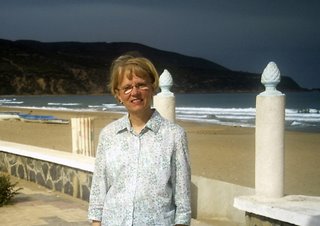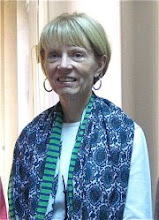Oran
 Raï is not the only modern cultural expression associated with Oran. Nobel prize winner Albert Camus was born here, and he located many of his stories to Oran. The plague in his The Plague is probably inspired by the cholera epidemic of 1849. The intense heat plays a role in some of Camus' writings; but the weather here today is in the 70s and overcast.
Raï is not the only modern cultural expression associated with Oran. Nobel prize winner Albert Camus was born here, and he located many of his stories to Oran. The plague in his The Plague is probably inspired by the cholera epidemic of 1849. The intense heat plays a role in some of Camus' writings; but the weather here today is in the 70s and overcast. Sites
The beach on the city's edge isn't so good; but there are great ones just outside. This picture of me is at Les Andalouses, popular with tourists in the summer. Santa Cruz, a large fort built by the Spanish in the 16th century, is atop Mount Murdjadjo and dominates the city. Notre dame de Santa Cruz, a cathedral just below the fort, offers a great view, as the fort is closed for restoration. The Spanish ruled here at various times for about three centuries; and the city was founded by Andalousian traders in the 10th century. Sacred Heart Cathedral near the city center is now a public library. The Great Mosque of the Pasha was built in 1796 by Muhammad El Kabir. Nonmuslims can't enter it at the present time. Another interesting site is the Kouba (mausoleum, dating from 1793)) of Marabout Sidi el Houari, the patron saint of the city. It seemed to be a site of particular religious devotion. Many women were sitting on the floor in the interior and a number of beggars were seated outside asking for alms. I wasn't encouraged to visit or take pictures. Women and children seem to be its primary visitors. November First Square had a large pillar-type monument, with stone portraits of Oran's early nationalist hero, Amir Abdelkader, just above the base, topped by a statue of La Victoire Ailée (Winged Victory). The Hotel de Ville (city government) and Opera House face the square, decorated with a fountain, greenery, walkways. Carriage rides are on offer in the square.
Oran is the second largest city after Algiers (abjout 800,000), growing from a metropolis of only 4,000, when the French arrived in 1831. More women wear jellabahs than in the capital. The hectic traffic of Algiers is not to be seen. From that perspective, the city seems more liveable, if not as prosperous. More poverty is evident from the shantytown complexes and debris, which have grown up around the city's edge. The city squares could be cleaner; and much of the over-40 population looks like it could use better health care. Oran has a more popular, industrial, and commercial atmosphere than the capital and much of it dates from more recent years. It has a university and an important research center, CRASC (Centre de Recherche en Antropologie Sociale et Culturelle), where I'll set up my office, Saturday, October 28. Nouria Remaoun, the Director, is my sponsor as a Fulbright Senior Regional Research Scholar in Algeria. Tourism is not a big industry (at least compared to Morocco and Tunisia), so the average person doesn't know much about the cultural and historical heritage of the city.
The Banal v. The Creative
I'm enjoying my time in the economic capital of the west and the great views over the Mediterranean. Camus saw Oran as a treeless, barren city, set against the rocks and the sea. The sun, the heat, the wind, and the changing seasons, as seen in The Plague, reflect the various stages of the plague. The people of Oran are much like people everywhere, with their narrow visions and their bourgeois values. Camus stresses the banal aspect of the city and its life. I think this could be true of any city, if one didn't work to change it. Some in the overdeveloped world have far more material advantages. Whether they're taking advantage of the opportunity is another question. It was Sinclair Lewis, who wrote Main Street, a satire of small-town America, where young Carol Kennicott goes to Gopher Prairie, Minnesota, and dreams of transforming the provincial town into a place of beauty and culture. However, she runs into a wall of bigotry, hypocrisy and complacency.


0 Comments:
Post a Comment
<< Home